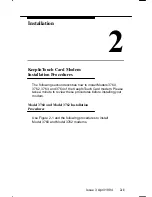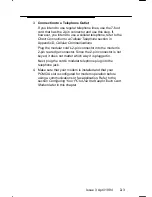
3-4
Issue 3 April 1994
@ – Quiet answer. Wait for five seconds of silence after dialing
the number. If the silence is not detected, the modem
sends a NO ANSWER result to the computer.
! –
Hook flash. This causes the modem to go on-hook for a
specific time period, then return to off-hook. The amount of
time the modem will be on-hook varies by country. Refer to
Table 4-3 in Chapter 4 for the hook flash time period for
your country.
; –
Return to Command mode. Allows AT command strings
that exceed the 40-character limit to be linked together.
This is useful when using a calling card number or an
international telephone number. Modem returns to
Command mode after dialing a number without
disconnecting the call.
A dial string example for a local call using tone dialing:
TYPE: ATDT 5551234
where
D is the dial command, T is the Tone dialing
modifier, and
555-1234 is the telephone number.
PRESS: Enter
If you would like to know more about the function of the dial
command, refer to the following commands in Chapter 4: DL
(Dial Last Number), P (Pulse), T (Tone), &Z (Store Telephone
Numbers), S6 (Blind Dial Pause Time), S7 (No Answer
Time-out), and S8 (Dial Modifier Pause Time).
Disconnecting a Call
Three ways you can disconnect a call are the any-key abort
function, the H command, and DTR disconnect. The modem
will disconnect if any key on the keyboard is pressed while the
modem is dialing a call or is engaged in the handshaking
process. The handshaking process occurs when the two
modems connect, and then spend a brief period deciding how
they will transfer data, the speed of the transfer, and if error
control will be used. This is usually identified by the high-pitched
tones emitted by your modem.






























